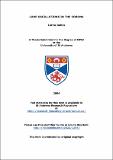Loop oscillations in the corona
Abstract
Magnetic loops in the Sun's corona have been discovered to oscillate in a variety of modes. The oscillations are observed to exhibit strong damping. A number of theories have been put forward to explain the damping, including resonant absorption and phase mixing. Here we consider the modelling of loop oscillations, paying particular attention to two effects: gravity, and the addition of a chromospheric layer below the corona. We develop an acoustic model of coronal loop oscillations and consider two ways of describing the effects of the gravitational stratification and the chromospheric layers, considering either two media separated by a discontinuous interface or a single medium with a sound speed that varies along the loop. A dispersion relation for the two-layer isothermal atmosphere case is obtained and investigated numerically using a bisection code. On comparison with roots obtained for a single isothermal atmosphere, it was found that the effect of chromospheric footpoints on the period of a mode is slight. However, the effect of gravity was found to be more notable, rising up to a twenty percent change in period when considering the longer observed loops. This result is of especial interest since gravity is often ignored by authors discussing loop oscillations. The case of a linear sound speed has been investigated analytically, obtaining a dispersion relation in terms of Bessel functions. Our results show that the Bessel equation is a possible solution for describing the wave modes.
Type
Thesis, MPhil Master of Philosophy
Collections
Items in the St Andrews Research Repository are protected by copyright, with all rights reserved, unless otherwise indicated.

